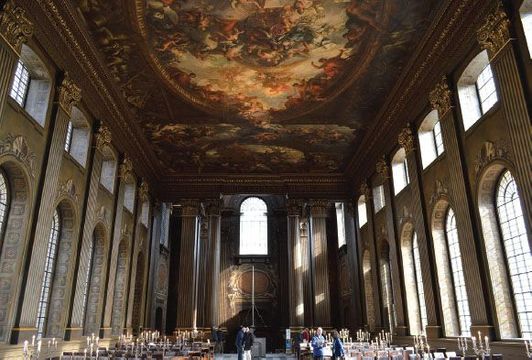
Greenwich has played host to royalty, and especially female royalty, since time immemorial. Queens, consorts—and the occasional mistress—have all been welcomed and indulged by a riverside town that takes most things in its stride. Queen Elizabeth I was born at Greenwich Palace and, in 2012, Queen Elizabeth II recognized Greenwich as one of just six Royal boroughs in the land.
Greenwich has played host to royalty, and especially female royalty, since time immemorial. Queens, consorts—and the occasional mistress—have all been welcomed and indulged by a riverside town that takes most things in its stride. Queen Elizabeth I was born at Greenwich Palace and, in 2012, Queen Elizabeth II recognized Greenwich as one of just six Royal boroughs in the land.
Greenwich Palace was demolished after the English Civil War. In its place, Sir Christopher Wren built a magnificent almshouse at the bequest of Queen Mary II, distressed at the number of disabled sailors living in poverty on London’s streets. At the epicenter of Greenwich Hospital stood the Painted Hall, decorated ceiling to floor by Sir James Thornhill between 1708 and 1727.
It’s still one of the finest rooms in Europe, but 300 years of smoke and pollution have taken their toll. The hall has just closed for refurbishment, which makes it the perfect opportunity to visit. No, really. In order to restore the ceiling, conservators are building a gigantic scaffolding cage and—here’s the brilliant bit—from April visitors will be able to take an elevator to the platform and watch the ongoing work. Uniquely, visitors will find themselves mere inches away from this baroque masterpiece. Timed tickets will be available from January.
As the Painted Hall begins its conservation, another palace, built for another Queen, has just completed its stunning restoration. It’s said King James I gave the “House of Delights” to his Queen, Anne of Denmark, as an apology for losing his temper when she accidentally shot one of his hunting dogs. It’s as good a story as any.
[caption id="RegalEchoesinRoyalGreenwich_img2" align="aligncenter" width="582"]
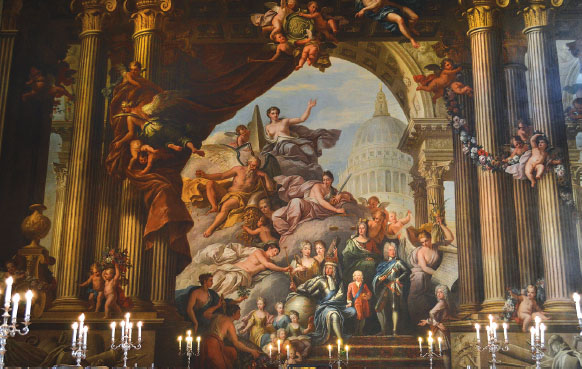
ALL PHOTOGRAPHY BY SANDRA LAWRENCE
Whatever its instigation, the Queen’s House is truly important. Built by Inigo Jones, it was the first Palladian building in England, incorporating a perfect cube at its center. Oddly, it originally straddled the main road to Dover, so the Queen could enjoy both the river and Greenwich Park.
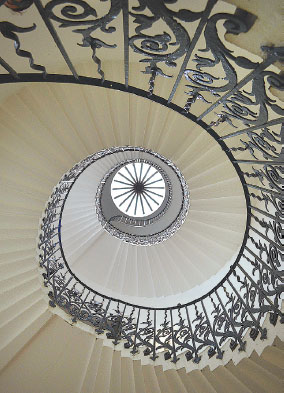
ALL PHOTOGRAPHY BY SANDRA LAWRENCE
The restoration is gorgeous. Gold paint has been replaced with gilding, modern, brilliant white paint replaced with a subtler, more authentic cream. The ceiling of the Great Hall, originally painted by Orazio Gentileschi, was “given away” by Queen Anne, cut down and installed at Marlborough House just off Piccadilly.
Inigo Jones’s elegant Tulip Staircase adorns
the Queen’s House.
Turner Prize-winning artist Richard Wright was commissioned to create something new to fill the 300-year-oldInigo Jones’s elegant Tulip Staircase adorns the Queen’s House.gap. Turner Prize–winners aren’t noted for their dedication to the traditional. What Wright has created, however, is both contemporary and beautiful.
Gentileschi may not live on the ceiling again, but elsewhere, he has returned with a passion. Now one of the most important masterpieces, Gentileschi’s Joseph and Potipher’s Wife, has finally returned, on loan from the Royal Collection. Another 49 old masters are also being lent from the great galleries and collections of Britain, which join some pretty famous daubs already owned by Royal Museums Greenwich.
Emma Hamilton was the Queen of Celebrity in the early 19th century. A new exhibition at the National Maritime Museum, Seduction and Celebrity, explores young Emma Hart’s life from poverty to poverty, via wealth, fashion and notoriety to her untimely, tragic death 10 years after she lost the love of her life, Admiral Lord Nelson.
[caption id="RegalEchoesinRoyalGreenwich_img3" align="alignleft" width="284"]
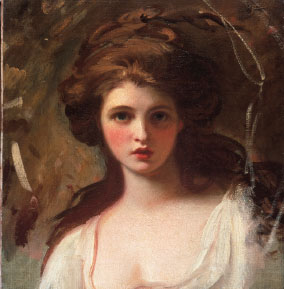
ALL PHOTOGRAPHY BY SANDRA LAWRENCE
A superbly curated show, it includes scores of items owned by or associated with Emma, many of which have never been displayed before, and allows us to explore a typically masculine world through her very feminine eyes. Several paintings of her, many by George Romney, crowd one wall in a way that reminded me of the Grand Tour soirees Emma held in Naples.
At the heart of the exhibition is her lover’s famous coat, worn at the Battle of Trafalgar and still bearing the hole from the bullet that killed him. It is one of the only articles she was allowed to keep, and even that only grudgingly, on loan. Despite Nelson’s specific wishes, Emma was left out of his estate, and she died penniless, having even parted with that precious coat to pay debts.
While the jacket is in the exhibition, don’t miss the rare opportunity to see Nelson’s other famous coat, worn at the Battle of the Nile. The jewel of any other collection, this priceless undress uniform usually languishes in storage, but while Seduction and Celebrity is running, it takes pride of place in the Nelson galleries upstairs.
It’s unlikely Emma ever met that other Regency scarlet woman, Caroline of Brunswick, the hated consort of Royal slob George IV. He was abominably rude about her even before he met her, and when he did he took one look and announced he felt sick. Caroline gave as good as she got and, exiled to Montagu House on the edge of Greenwich Park, she devoted herself to being a thorn in his side. He was furious at her outrageous behaviour, a case of the Royal pot calling the Royal kettle black, since his own conduct was widely abhorred by the public. The altogether earthier folk of Greenwich rather admired Caroline’s feistiness and many peccadilloes.
When she died George wasted no time in pulling down Montagu House, but he missed one little detail. If the weather is decent, and you’re fancying a mini-quest, you might fancy seeking out Princess Caroline’s Bath. The walk-in pool’s remains lie in the southwest part of the park, just north of the Rose Garden. Go find it, close your eyes and imagine the laughter and splashes of a princess cavorting with her true friends in defiance of her boorish husband.
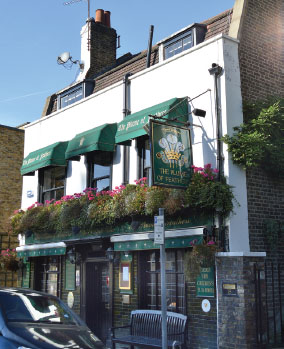
ALL PHOTOGRAPHY BY SANDRA LAWRENCE
Don’t rush inside too quickly. The vicarage opposite incorporates a little square brick water-house, all that’s left above ground of the old Greenwich Palace. On the wall, witness a carvedstone heraldic plaque. Look down to a row of iron studs in the street that marks the Meridian line. You can pose for a classic feet-across-the-world photo op. Watch out for oncoming vehicles!
CONTACTS
Painted Hall—ornc.org/paintedhall
Queen’s House—rmg.co.uk/queens-house
Emma Hamilton: Seduction and Celebrity—rmg.co.uk/see-do/emma-hamilton-seduction-and-celebrity
Plume of Feathers—plumeoffeathers-greenwich.co.uk





Comments